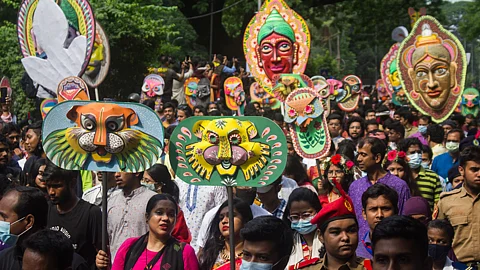
- HOMEGROWN WORLD
- #HGCREATORS
- #HGEXPLORE
- #HGVOICES
- #HGSHOP
- CAREERS
- ABOUT US
- CONTACT US

"If you are Bengali, you may know much of what you read here," author Sudeep Chakravarti writes in his book 'The Bengalis: A Portrait of a Community'. "If you are not Bengali, to the Bengali you may not matter at all (...) you are what Bengalis call ‘non-Bengali’. It is closer to non-person than persona non grata."
Recent weeks have seen a disturbing escalation in police crackdowns on Bengali migrant workers in Hindi-speaking states, framed as efforts to flush out so-called 'Bangladeshi infiltrators' — a right-wing dog whistle for Bengali Muslims. In many cases, people have been singled out for speaking Bengali in non-standard dialects, with the Delhi Police even referring to Bengali as “the Bangladeshi national language” in a now-viral letter.
Naturally, Bengalis have come out in protest against this ethnic and linguistic profiling. As the debate over the false binary of 'Indian Bengalis' and 'Bangladeshis' rages online, I have been thinking about how much of this stems from a historical and cultural misunderstanding of Bengal and Bengalis. The image of Bengalis as the other derives from an unawareness of the nuances of Bengali history and identity, as well as the Bengali proclivity for otherness Chakravarti mentions in The Bengalis. The 'Baudhayana Dharma Sutra' — a Sanskrit text composed between 600 and 300 BCE — states that Anga (Bihar), Vanga (Bengal), and Kalinga (Odisha) shall not be visited for purposes other than pilgrimage.
This historical othering has roots in who inhabited these regions and how they were seen by the rest of India. A fertile delta at the crossroads of South and Southeast Asia, Bengal has always been a melting pot of different peoples, tribes, and communities. Prior to the first millennium BCE, Bengal was inhabited by Austroasiatic, Dravidian, and Tibeto-Burman peoples who settled in the region through several prehistoric waves of migration.
Ancient Settlers and Early Diversity
The earliest inhabitants of Bengal were likely Austroasiatic-speaking rice cultivators, related to the Munda peoples of eastern India, who settled in the region around 1,500 BCE. They introduced wet-rice agriculture and linguistic traits that can still be seen in rural Bengali vocabulary today. Genetic studies indicate that Bengalis have traces of Southeast Asian ancestry, likely stemming from these early Austroasiatic migrations. Archaeological and linguistic evidence also suggests contact with proto-Dravidian populations around the same time (1,500-1,000 BCE), possibly linked to early rice cultivation and settlement patterns in Bengal's southwest.
A second wave of migration and settlement occurred between 1,000 and 500 BCE with the arrival of Indo-European speakers in the Bengal delta. Bengal developed a mixed cultural profile during this period — blending Vedic ritualism with indigenous animistic traditions. Genetic signatures from this era reflect a North Indian–Gangetic admixture over earlier Austroasiatic/Dravidian bases.
Medieval Migrations and The Emergence of Religious Syncretism
From the 8th century onward, migrants and traders of Arab, Turkish, and Persian descent arrived, adding new cultural and genetic layers to the different peoples and communities of Bengal. In the Buddhist period, Tibeto-Burman population groups arrived and settled in the northern parts of present-day West Bengal and Bangladesh. Bengal's riverine geography connected it to the Bay of Bengal trade routes, bringing merchants from Sri Lanka, Southeast Asia, and later China into the region, while the people of Bengal colonised, settled, and mixed with the indigenous populations of Java and Sumatra during the Pala era.
In the 13th century CE, Turkic, Afghan, and Persian rulers brought West and Central Asian genetic input along with Islamic art, architecture, and literature. The Bengali Muslim identity emerged from a fusion of local Bengali culture and Persianate court traditions. Persian and Arabic loanwords enriched the Bengali language, especially in eastern Bengal where many historically oppressed caste groups and tribes converted to Islam to escape Brahminical oppression and hegemony within Hindu caste society.
Colonial and Global Connections
This cultural exchange and cross-pollination continued in the colonial period. Portuguese traders and missionaries settled in Bengal, particularly Hooghly, introducing new crops, words, and even surnames. Armenian merchants established communities in Calcutta, acting as middlemen in the Indian Ocean trade. In 1772, Calcutta became the capital of British India, drawing migrants from across the subcontinent and beyond — Parsis, Marwaris, Chinese, Anglos and Creoles — adding to the genetic and cultural mosaic.
The Modern Bengali: A Many-Layered Identity
Modern Bengalis are the result of this complex, many-layered history of migration, marriage, cultural exchange and cross-pollination. The modern Bengali language — or rather family of dialects and languages — is a result of Indo-European grammatical influences and core vocabulary, but also contains Austroasiatic, Dravidian, Persian, Arabic, Portuguese, and English loanwords. Bengal's religious identity, too, is deeply syncretic. While Hinduism and Islam remain dominant, everyday religious beliefs are also shaped by older Buddhist and animist rituals and traditions. Modern Bengali cuisine is an evolution of the rice-fish based diet from Austroasiatic times, spiced with Persian roasting and stewing traditions, Portuguese fermentation and preservation techniques, and British tea and snack culture.
Bengalis today trace their origins to this long history of migration and cultural blending, shaped by waves of different communities settling in the region over many centuries. Over time, these diverse populations intermingled, giving rise to the Bengalis as we are known today. To profile Bengalis by dialect or to divide the community into 'Indian' and 'Bangladeshi' is to deny the very history that made Bengal and Bengalis.
To learn more about the collective history of Bengal and Bengalis, read Sudeep Chakravarti's 'The Bengalis: A Portrait of a Community'.
If you enjoyed reading this, here's more from Homegrown:
Puppets Of Desire: The Enduring Power Of Manik Bandyopadhyay's 'Putul Nacher Itikotha'
The Indigo Revolt: When Colonial-Era Bengali Farmers Rebelled Against The British Raj
The Shapes Of Sandesh: Why The Intricate Moulds For This Bengali Sweet Are Fading Away
